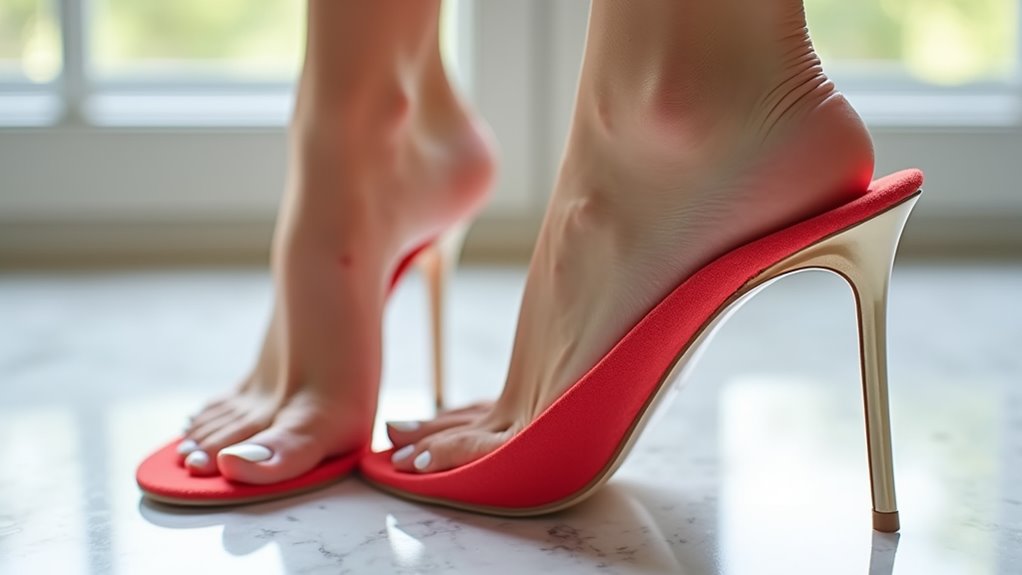There may be products. Products are independently selected by our editors. We may earn an affiliate commission from the links with no charge to you, example: as Amazon Affiliate.
While 75% of women report significant foot pain from high heels, you don’t have to become part of this statistic. Your choice of footwear today can determine whether you’ll maintain healthy feet or develop chronic problems like bunions, hammer toes, or plantar fasciitis in the future. The daily decisions you make about heel height, shoe fit, and wearing duration play a crucial role in preventing long-term damage to your feet, ankles, and posture. Understanding the science behind proper heel wearing and implementing preventive strategies can help you enjoy fashionable shoes without compromising your foot health.
Key Takeaways
- Limit heel height to under two inches and reserve high heel wear for special occasions rather than daily use.
- Perform daily stretching exercises for Achilles tendons and calf muscles to prevent tightness and potential injuries.
- Choose shoes with adequate toe box space, cushioning, and ankle support to minimize pressure on foot structures.
- Alternate between different shoe heights throughout the week and use cushioned mats when standing for long periods.
- Practice regular foot inspections and incorporate foot-strengthening exercises to maintain stability and prevent deformities.
Understanding High Heel Health Risks
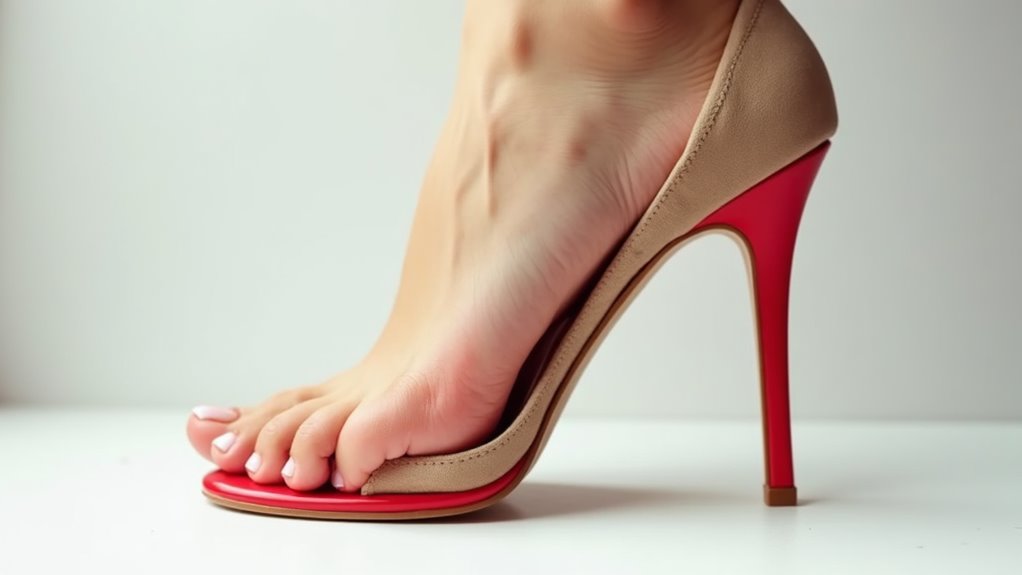
While high heels may enhance your appearance, they pose numerous health risks that can affect your entire body. When you wear high heels, excessive pressure on your foot bones can lead to stress fractures and chronic pain. Your ankles become less stable, increasing your risk of sprains, while your calf muscles and Achilles tendons gradually shorten.
You’ll notice that high heels force your toes into cramped positions, potentially causing bunions and hammertoes. The altered posture from wearing heels doesn’t just affect your feet – it can trigger a chain reaction throughout your body.
Your pelvis tilts forward, your lower back arches abnormally, and you may develop neck pain and headaches. Over time, these issues can evolve into chronic conditions like metatarsalgia, plantar fasciitis, and persistent inflammation in your legs and back. Fortunately, modern comfort-focused heel designs can help minimize these health risks while maintaining style.
Smart Heel Selection Guidelines
You’ll find the perfect heel height by keeping them under two inches to minimize pressure on your feet while maintaining comfort and stability.
The ideal width should allow your toes to spread naturally within the shoe, with a generous toe box that prevents cramping and discomfort.
For optimal support, look for heels with secure ankle straps and cushioning at pressure points, particularly if you have specific foot characteristics like high arches or flat feet.
Experience lasting relief with premium comfort heels designed specifically to provide superior cushioning throughout the day.
Measuring Perfect Heel Height
The path to finding your perfect heel height begins with precise measurement techniques and an understanding of your foot’s natural anatomy.
To get started, measure from the back of your heel to the ball of your foot while keeping it relaxed – not pointed or flexed. Take multiple measurements and average them for accuracy, and don’t forget to measure both feet.
Your foot shape and Talus bone flexibility will determine your ideal heel height. If you’re flexible, you can wear heels up to 7-12cm comfortably.
However, you’ll want to stay under 8cm if comfort is your priority, with a heel arch of 160 degrees or less. For optimal foot health, consider limiting yourself to two-inch heels or less, and opt for kitten heels when possible.
Optimal Width and Support
Selecting optimal width and support features in heels can make the difference between comfort and chronic foot pain.
You’ll need a toe box that matches your foot’s natural shape, with edges that align flush against the footbed. If you have wide feet, opt for open-toe styles with ankle straps, while narrow feet do well with multiple straps for secure fitting.
Your arch type should guide your choice of support features. High arches need shock-absorbent materials and curved-in heels, while flat feet require wide toe boxes and substantial arch support.
Choose block heels or platforms for better weight distribution and stability. For thin heels, always select styles with ankle straps.
Consider leather shoes, as they’ll mold to your feet over time, and don’t forget that gel insoles can enhance comfort in any style.
Daily Prevention Practices
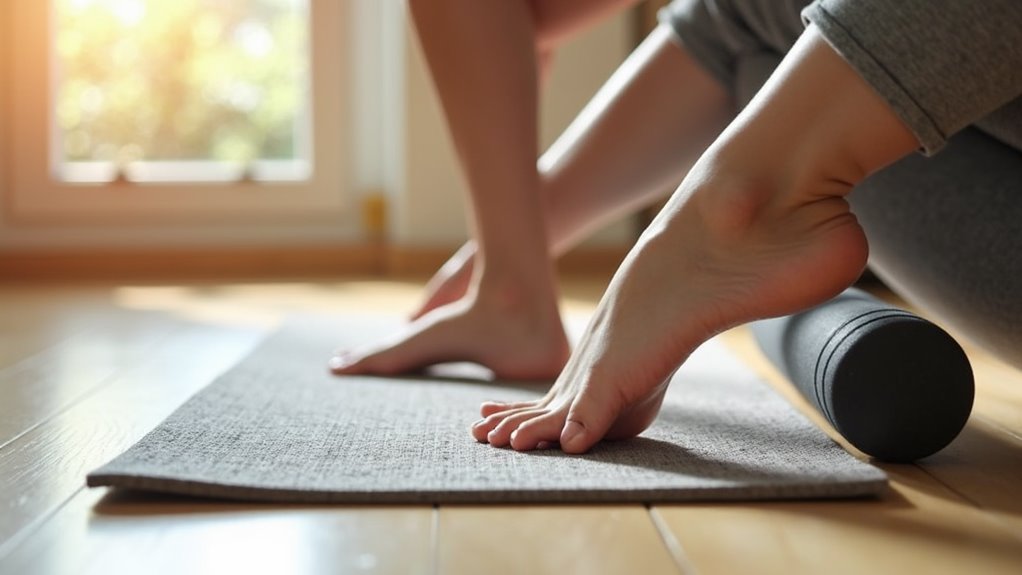
Implementing daily foot care routines can significantly reduce your risk of developing long-term heel problems.
Start by stretching your Achilles tendon and calf muscles every morning to improve foot mechanics and reduce strain. You’ll also want to perform heel raises and plantar fascia stretches to strengthen your lower leg muscles.
If you’re standing for long periods, use cushioned mats at your workstation and alternate between sitting and standing.
When exercising, mix low-impact activities like biking with your regular routine to prevent overuse injuries.
Don’t forget to maintain proper foot hygiene, trim your toenails straight across, and address any wounds promptly.
If you experience persistent heel pain, don’t hesitate to consult a medical professional for proper diagnosis and treatment.
Finding the right comfort solution online can help prevent many common foot problems before they start.
Essential Foot Care Tips
Building on your daily prevention routine, proper foot care remains a cornerstone of long-term foot health. You’ll want to wash your feet daily with soap and water, making sure to dry thoroughly between your toes. Apply moisturizer to your feet at night, but avoid putting it between your toes where moisture can build up. When trimming nails, cut straight across and file any sharp edges gently. Consider switching to eco-friendly shoes that are sustainably manufactured to reduce environmental impact while maintaining foot health.
| Essential Care | Why It Matters |
|---|---|
| Daily washing | Prevents bacterial growth |
| Proper drying | Reduces fungal risks |
| Nail trimming | Prevents ingrown toenails |
| Regular inspection | Catches issues early |
| Moisturizing | Maintains skin health |
Remember to wear well-fitting shoes that provide proper support, and don’t forget to protect your feet from sun exposure when wearing open footwear.
Recovery and Pain Management
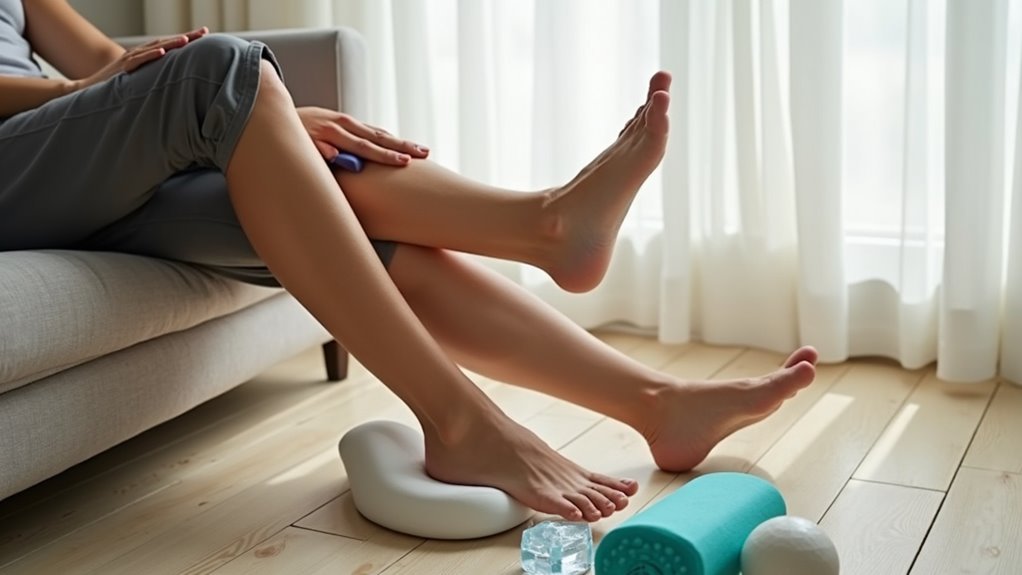
Effective recovery and pain management strategies are crucial when dealing with heel-related foot problems. When you’re experiencing discomfort, follow the RICE method: rest your feet, apply ice to reduce inflammation, use compression bandages, and elevate your feet above heart level.
You’ll find relief through over-the-counter pain medications like ibuprofen, while custom orthotics and night splints can provide additional support.
Don’t skip physical therapy – a professional can guide you through proper stretching exercises, including plantar fascia massage and calf stretches. Rolling your foot over a frozen water bottle can help reduce inflammation and pain.
For ongoing comfort, invest in supportive footwear with cushioned soles and wide toe boxes.
If pain persists, consult your doctor about prescription medication options.
Consider using podiatrist-recommended products to supplement your foot care routine and prevent future discomfort.
Building Foot Strength
Strong, resilient feet provide the foundation for healthy movement and pain-free walking, especially after prolonged heel wearing. You can strengthen your feet through targeted exercises that focus on key muscle groups. Start with toe curls and raises, holding each position for 10 seconds and repeating 10 times.
Practice marble pickup exercises to target the muscles on your foot’s underside, and incorporate toe spreading to enhance flexibility. Don’t forget arch raises – they’re crucial for maintaining proper foot support.
Focus on strengthening your intrinsic and extrinsic flexors, abductor hallucis, and plantar fascia through consistent practice. Wear appropriate footwear with good arch support and minimal heel height during recovery periods.
Combine these exercises with balance training by standing on one leg to improve stability and prevent future foot problems. Consider switching to eco-friendly heels made from sustainable materials to reduce stress on your feet while supporting environmental conservation.
When to Seek Medical Help
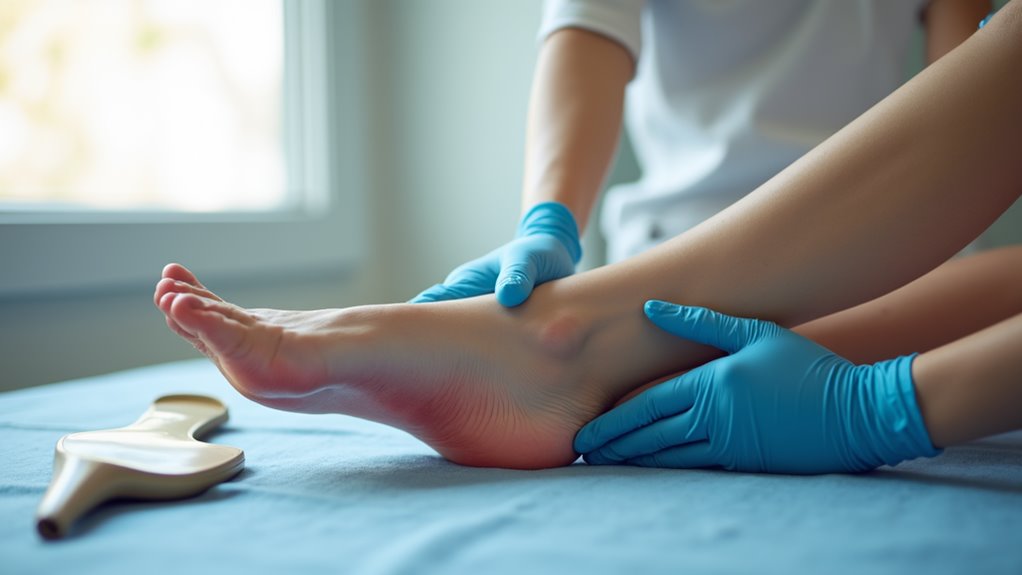
You should seek immediate medical attention if you experience severe heel pain accompanied by swelling, discoloration, or an inability to walk normally after wearing heels.
Watch for warning signs like persistent pain that occurs at night or while resting, any popping or grinding sounds during movement, or visible changes in foot shape.
If you have diabetes or notice signs of infection such as fever and redness, don’t wait to get medical help as these conditions can lead to serious complications.
Warning Signs of Damage
While wearing heels can be part of a fashionable wardrobe, it’s crucial to recognize signs of potential foot damage before they develop into serious problems. Pay attention if you’re unable to put weight on your foot or notice persistent swelling that doesn’t improve after 2-5 days.
Bruising around your heel and ankle area shouldn’t be ignored, nor should gradual pain development that takes weeks to manifest.
Watch for changes in your walking pattern, as difficulty maintaining your usual gait could indicate underlying issues. You should be particularly concerned if you experience burning sensations, numbness, or tingling across the bottom of your foot.
Additionally, if you find it challenging to bend your foot downward or stand on your toes, these symptoms may signal developing problems that require attention.
Emergency Medical Conditions
Recognizing when to seek emergency medical care for heel-related injuries can prevent severe complications and long-term damage. You’ll need immediate medical attention if you experience heavy bleeding from a foot laceration, hear a popping sound followed by severe pain, or notice signs of infection like warmth and redness, especially if you’re diabetic.
Don’t wait to get help if you experience:
- Sudden inability to bear weight on your foot accompanied by fever, chills, or nausea
- Red streaks spreading from your heel area, which could indicate a serious infection
- Deep wounds that aren’t healing properly, particularly if you have circulation problems
If you can’t walk or move your foot, or if you have persistent swelling that hasn’t improved after several days of home treatment, visit an emergency room immediately.
Conclusion
Your feet are the foundation of your daily journey, so treat them like precious gems. By following smart heel choices, daily care routines, and strengthening exercises, you’ll keep your feet dancing through life without the thorns of chronic pain. Remember, prevention is your shield against future problems, and if warning signs arise, don’t let them take root – seek professional help promptly.

